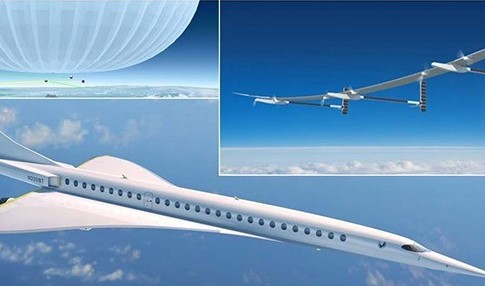Traditionally, Upper Class E airspace operations, which refer to those above flight level 600 (FL600), have been limited in scope due to the challenges of reduced atmospheric density for aircraft that fly at that altitude. However, recent innovation in power and propulsion technology, aircraft structures, flight automation, and aerodynamics has produced both manned and unmanned vehicles that overcome these limitations, including high altitude, long endurance (HALE) vehicles; unmanned free balloons (UFB); airships; and supersonic/hypersonic aircraft. These novel forms of aircraft can economically satisfy a variety of existing business and technical needs, including broad coverage services (i.e., earth sensing and telecommunications), supersonic passenger flight, and research. As a result, a burgeoning market has emerged in response to the increased demand for Upper Class E operations.
According to a report by the Federal Aviation Administration (FAA) Office of NextGen, these innovations are not without their challenges, however, but with challenge comes opportunity. The FAA’s Next Generation Air Transportation System, or NextGen, has recognized that transit involving Upper Class E airspace will increase in the future and will need a more scalable, flexible means of traffic management to accommodate diverse operational needs. Enter Upper Class E Traffic Management (ETM) — a cooperative airspace management concept currently in development by the FAA, NASA, and industry partners.
“Upper Class E has the unique challenge of accommodating a diverse set of vehicle types within its airspace,” said Michelle Cady, Project Manager and Systems Engineering Lead for NextGen’s Technology Development and Prototyping Division. “There are several reasons why the development of ETM is crucial to the safety and efficiency of the NAS.”
Indeed, the increase in demand for upper Class E operations present novel challenges for the current communications, navigation, and surveillance (CNS) infrastructure and airspace management model. The anticipated increase in operations, along with disparate vehicle performance characteristics and unconventional operational needs, require fresh solutions.
Leveraging other related approaches, such as UAS Traffic Management (UTM), the collaborative effort with industry is developing a unique traffic management approach that will scale to support future upper Class E operations and ultimately inform application on a global scale.
In 2019, the FAA and NASA conducted two tabletop exercises at NASA Ames Research Center to understand stakeholder visions and future operations in Upper Class E airspace. The first was held in April to initiate discussions around the Concept of Operations for ETM and establish common principles about the operating environment. In December, the same stakeholders focused on air traffic control (ATC) interactions with vehicles transiting to and from Upper Class E airspace, as well as contingency procedures and a concept for a flexible floor for cooperative separation between FL500 and FL600.
The ETM Concept of Operations (ConOps) v1.0 reflects these collaborative efforts in forming the initial vision of traffic management of manned and unmanned aircraft operations in high altitude airspace. The ConOps examines how ETM Operators
- Plan their flights for high altitude operations;
- Interact with the ATM system and ATC during transition to and from Upper Class E Airspace; and
- Manage contingency events.
It also examines foundational operating principles for cooperative traffic management in Upper Class E Airspace and introduces the concept of cooperative separation in certain portions of Upper Class A airspace. Subsequent versions of the ConOps will more comprehensively address cooperative traffic management approaches for this airspace, with continued collaboration with and input from industry.
The ETM ConOps V1.0 was released in May 2020 and will help to inform the policies, regulations, services, and infrastructure required to support safe and equitable operations in the NAS.
While NextGen and its partners continue to develop and mature ETM concepts parallel with industry innovation, they have initiated efforts to introduce the concept to other FAA organizations and, ultimately, the public.
According to Sherri Magyarits of NextGen’s New Entrants Division, “ETM is an exciting venture into the high-altitude realm. It is another example of how the FAA and NASA continue to embrace technological innovation and develop novel approaches to traffic management in collaboration with industry stakeholders to achieve everyone’s objectives.”
For further information visit:
https://www.faa.gov/uas/advanced_operations/upper_class_etm/
https://medium.com/faa/new-kid-on-the-block-an-introduction-to-upper-class-e-airspace-d0ef37001839




